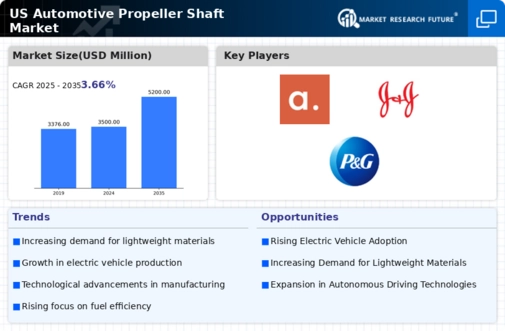The automotive propeller shaft market is currently characterized by a competitive landscape that is both dynamic and multifaceted. Key growth drivers include the increasing demand for fuel-efficient vehicles, advancements in manufacturing technologies, and a growing emphasis on sustainability. Major players such as GKN Automotive (US), Dana Incorporated (US), and American Axle & Manufacturing (US) are strategically positioned to leverage these trends. GKN Automotive (US) focuses on innovation in lightweight materials and advanced manufacturing processes, while Dana Incorporated (US) emphasizes its commitment to sustainability through the development of electric vehicle components. American Axle & Manufacturing (US) is enhancing its operational focus on expanding its product portfolio to include more advanced driveline technologies, thereby shaping a competitive environment that is increasingly reliant on technological advancements and sustainability initiatives.
Key business tactics employed by these companies include localizing manufacturing to reduce costs and optimize supply chains. The market structure appears moderately fragmented, with several key players exerting considerable influence. This fragmentation allows for a diverse range of products and innovations, although it also intensifies competition among established and emerging players alike. The collective influence of these key players is significant, as they drive trends in product development and market expansion.
In November 2025, GKN Automotive (US) announced a partnership with a leading electric vehicle manufacturer to develop next-generation propeller shafts designed specifically for electric drivetrains. This strategic move is likely to enhance GKN's position in the rapidly growing electric vehicle segment, aligning with the industry's shift towards electrification and sustainability. The collaboration is expected to yield innovative solutions that could redefine performance standards in the market.
In October 2025, Dana Incorporated (US) unveiled its new line of lightweight propeller shafts aimed at improving fuel efficiency in conventional and hybrid vehicles. This initiative underscores Dana's commitment to sustainability and innovation, as the new products are designed to reduce overall vehicle weight while maintaining durability. Such advancements may provide Dana with a competitive edge in a market increasingly focused on environmental impact and efficiency.
In September 2025, American Axle & Manufacturing (US) completed the acquisition of a technology firm specializing in advanced materials for propeller shafts. This acquisition is anticipated to bolster American Axle's capabilities in developing high-performance products that meet the evolving demands of the automotive industry. By integrating cutting-edge technology into its offerings, American Axle is likely to enhance its competitive positioning and drive future growth.
As of December 2025, current competitive trends in the automotive propeller shaft market are heavily influenced by digitalization, sustainability, and the integration of artificial intelligence (AI) in manufacturing processes. Strategic alliances among key players are shaping the landscape, fostering innovation and collaboration. The shift from price-based competition to a focus on technological differentiation and supply chain reliability is evident. Companies that prioritize innovation and sustainability are likely to emerge as leaders in this evolving market.














Leave a Comment